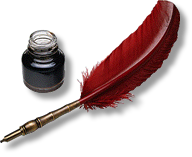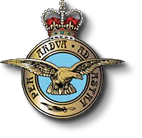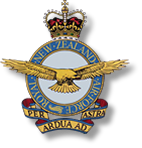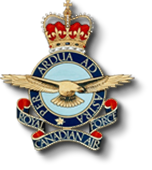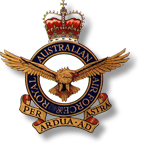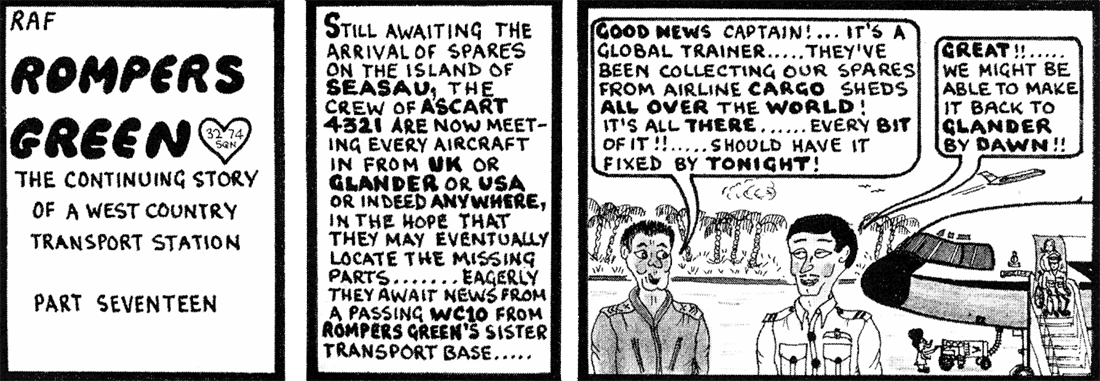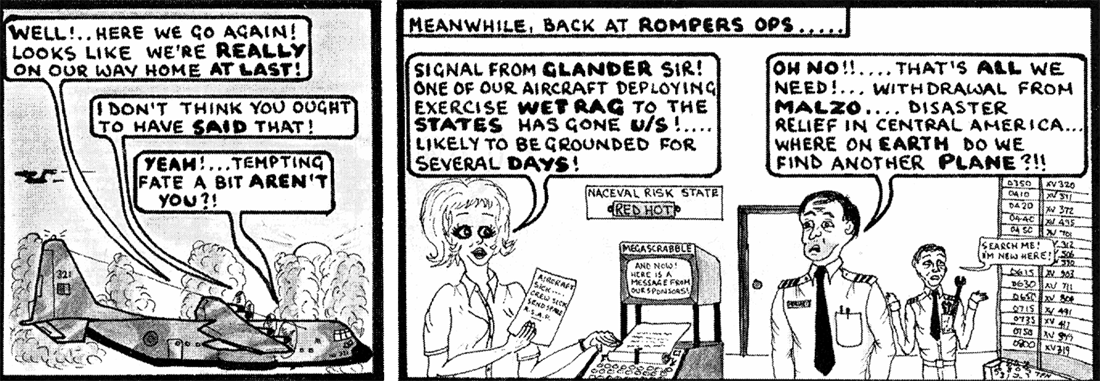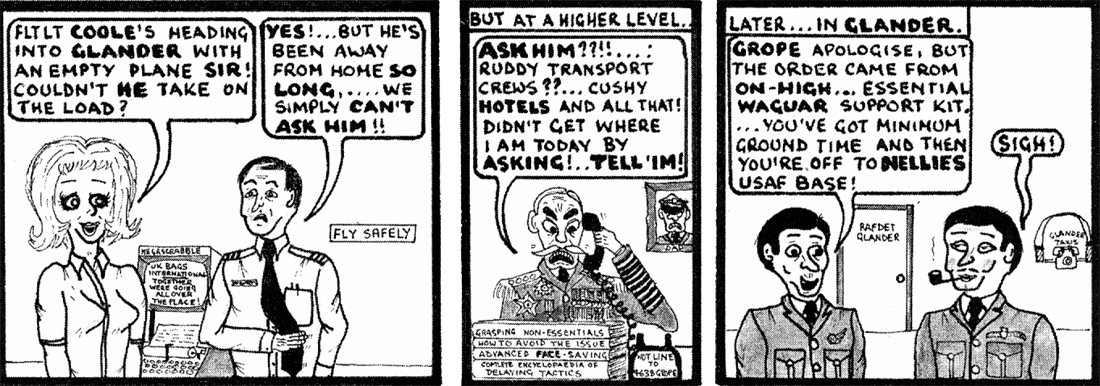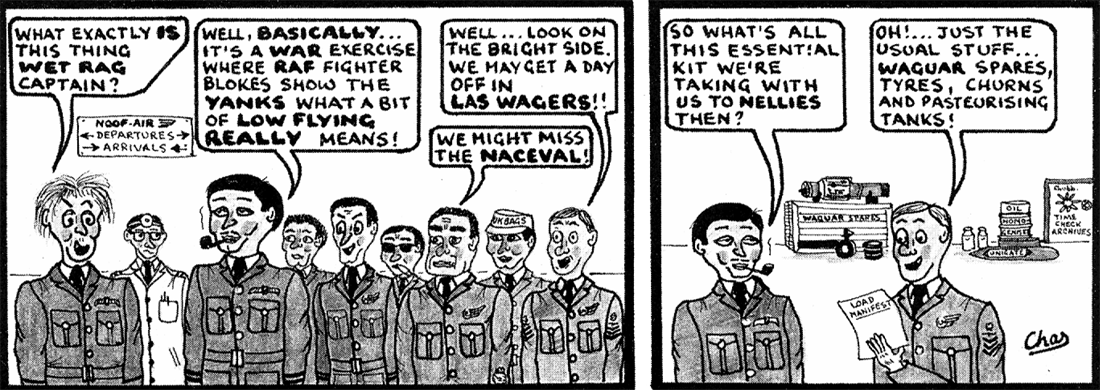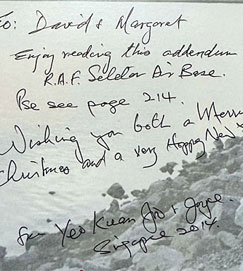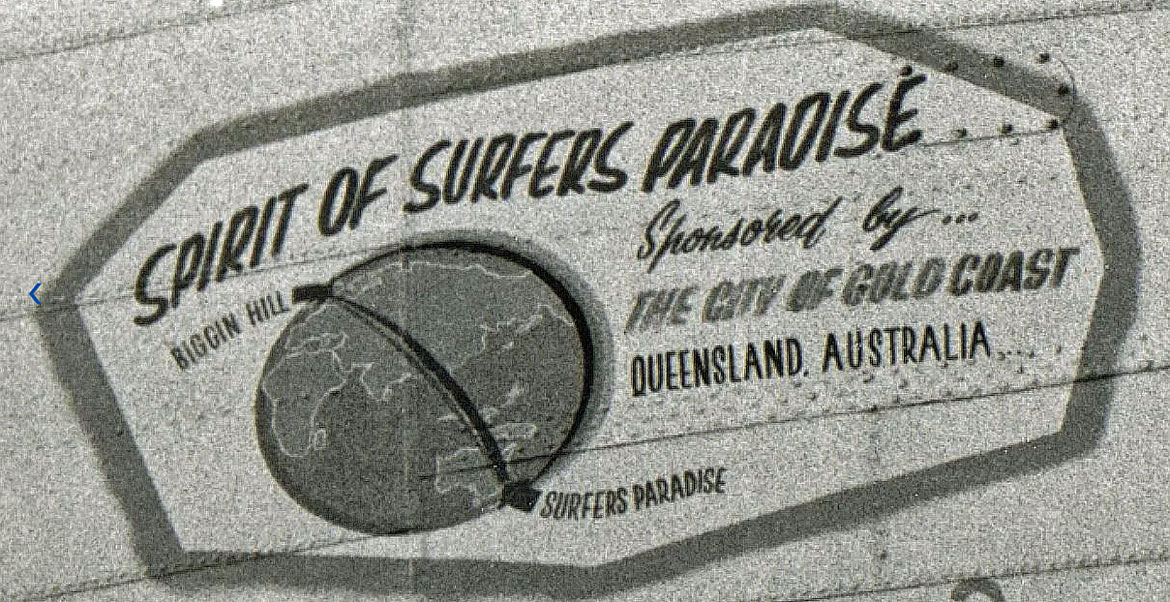


UK announces 2.5% GDP spending on defence,
biggest strengthening for a generation
biggest strengthening for a generation
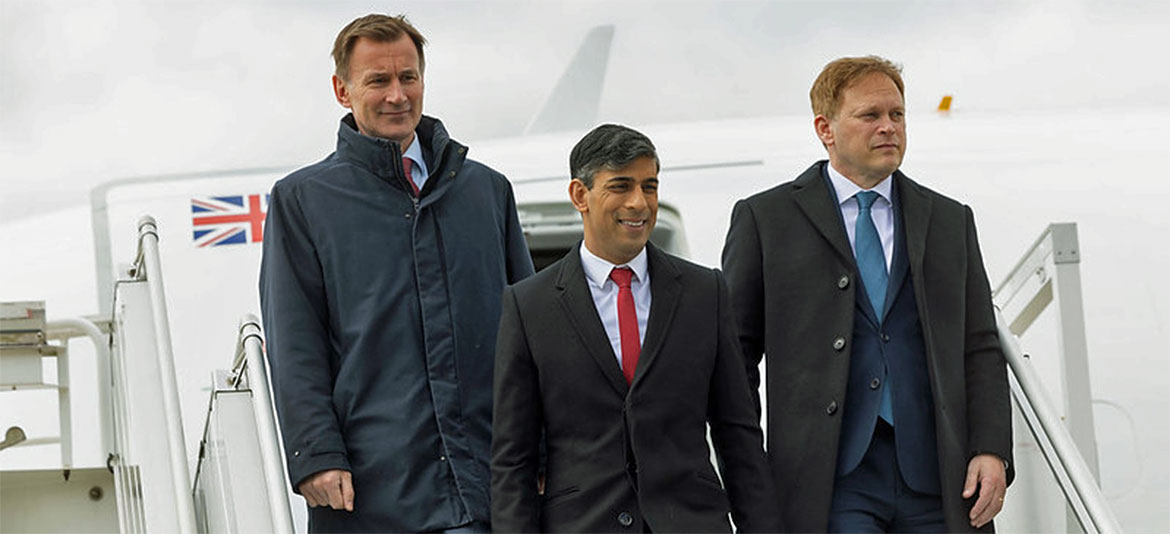
Chancellor Jeremy Hunt, Prime Minister Rishi Sunak and Defence Secretary Grant Shapps arriving in Poland
The Prime Minister has announced that the UK will spend 2.5% of gross domestic product (GDP) on defence by 2030. Rishi Sunak pledged that an extra £75bn would be spent on defence as a continuation of a commitment made by the Conservative Party under former PM Boris Johnson.
Mr Sunak said: "In a world that is the most dangerous it has been since the end of the Cold War, we cannot be complacent. As our adversaries align, we must do more to defend our country, our interests, and our values. That is why today I am announcing the biggest strengthening of our national defence for a generation. We will increase defence spending to a new baseline of 2.5% of GDP by 2030 – a plan that delivers an additional £75bn for defence by the end of the decade and secures our place as by far the largest defence power in Europe."
Mr Sunak, who set out the plan during his visit to Warsaw, Poland, alongside Chancellor Jeremy Hunt and Defence Secretary Grant Shapps, went on: "Today is a turning point for European security and a landmark moment in the defence of the United Kingdom. It is a generational investment in British security and British prosperity, which makes us safer at home and stronger abroad."
Despite the commitment, some in the Conservative party have called for GDP to be increased to 3%, including Defence Secretary Grant Shapps.
Following the announcement, shadow defence secretary John Healey said: "As Keir Starmer recently set out, Labour wants to see a fully funded plan to reach 2.5%, but the Tories have shown time and time again that they cannot be trusted on defence and we will examine the detail of their announcement closely. The British public will judge ministers by what they do not what they say. Since 2010, the Conservatives have wasted more than £15bn mismanaging defence procurement, shrunk the Army to its smallest size since Napoleon, missed their recruitment targets every year, and allowed morale to fall to record lows."
Under the new spending plan, the UK defence budget will increase immediately and then rise steadily to reach £87bn at the end of the decade. The UK has also pledged to spend a record £500m on Ukrainian aid, taking the amount spent this financial year up to £3bn.
Chancellor Jeremy Hunt said: "It speaks to Britain's global role that, with an improving economy, we are able to make this commitment to peace and security in Europe. It also sends the clearest possible message to Putin that as other Nato European countries match this commitment, which they will, he will never be able to outspend countries that believe in freedom and democracy."
Defence Secretary Grant Shapps said: "As I argued in my Lancaster House speech earlier this year, we are living in a much more dangerous world. Between Russia's invasion of Ukraine, Iran and its proxies seeking to escalate deadly conflict, and China flexing its muscles, there can be no doubt that the era of the peace dividend is clearly over. The mounting threats we face mean we must invest in defence if we are to continue to defend our values, freedoms and prosperity. Today's announcement marks the single greatest strengthening of our defence since the Cold War, which will support jobs, boost growth, and strengthen our incredible Armed Forces as a modern fighting force."
forces.net
Mr Sunak said: "In a world that is the most dangerous it has been since the end of the Cold War, we cannot be complacent. As our adversaries align, we must do more to defend our country, our interests, and our values. That is why today I am announcing the biggest strengthening of our national defence for a generation. We will increase defence spending to a new baseline of 2.5% of GDP by 2030 – a plan that delivers an additional £75bn for defence by the end of the decade and secures our place as by far the largest defence power in Europe."
Mr Sunak, who set out the plan during his visit to Warsaw, Poland, alongside Chancellor Jeremy Hunt and Defence Secretary Grant Shapps, went on: "Today is a turning point for European security and a landmark moment in the defence of the United Kingdom. It is a generational investment in British security and British prosperity, which makes us safer at home and stronger abroad."
Despite the commitment, some in the Conservative party have called for GDP to be increased to 3%, including Defence Secretary Grant Shapps.
Following the announcement, shadow defence secretary John Healey said: "As Keir Starmer recently set out, Labour wants to see a fully funded plan to reach 2.5%, but the Tories have shown time and time again that they cannot be trusted on defence and we will examine the detail of their announcement closely. The British public will judge ministers by what they do not what they say. Since 2010, the Conservatives have wasted more than £15bn mismanaging defence procurement, shrunk the Army to its smallest size since Napoleon, missed their recruitment targets every year, and allowed morale to fall to record lows."
Under the new spending plan, the UK defence budget will increase immediately and then rise steadily to reach £87bn at the end of the decade. The UK has also pledged to spend a record £500m on Ukrainian aid, taking the amount spent this financial year up to £3bn.
Chancellor Jeremy Hunt said: "It speaks to Britain's global role that, with an improving economy, we are able to make this commitment to peace and security in Europe. It also sends the clearest possible message to Putin that as other Nato European countries match this commitment, which they will, he will never be able to outspend countries that believe in freedom and democracy."
Defence Secretary Grant Shapps said: "As I argued in my Lancaster House speech earlier this year, we are living in a much more dangerous world. Between Russia's invasion of Ukraine, Iran and its proxies seeking to escalate deadly conflict, and China flexing its muscles, there can be no doubt that the era of the peace dividend is clearly over. The mounting threats we face mean we must invest in defence if we are to continue to defend our values, freedoms and prosperity. Today's announcement marks the single greatest strengthening of our defence since the Cold War, which will support jobs, boost growth, and strengthen our incredible Armed Forces as a modern fighting force."
forces.net

From: Mark Holland, Hodnet, Market Drayton, Salop
Subject: Visiting Aircraft
Hi Tony,
On the opposite end of the scale. A late night arrival at Brize. The Sultan of Oman’s VC10.
I was young and naive and I had never seen opulence like this aircraft before. I don’t remember seats just round day beds in rooms each divided from the next with a screen like Concorde showing the speed and height etc. But the best thing was they gave us the excess food for the night traffic shift. Oh man! To this day that was some of the best food I ever tasted; in fact sat here in the sunshine I am dreaming of it now (90% of the crew were ex-RAF and they knew how hungry we would have been!).
Cheers!
Mark
Subject: Visiting Aircraft
Hi Tony,
On the opposite end of the scale. A late night arrival at Brize. The Sultan of Oman’s VC10.
I was young and naive and I had never seen opulence like this aircraft before. I don’t remember seats just round day beds in rooms each divided from the next with a screen like Concorde showing the speed and height etc. But the best thing was they gave us the excess food for the night traffic shift. Oh man! To this day that was some of the best food I ever tasted; in fact sat here in the sunshine I am dreaming of it now (90% of the crew were ex-RAF and they knew how hungry we would have been!).
Cheers!
Mark


From: Tony Street, Fort Erie, ON
Subject: Visiting aircraft
Hey Tony,
A long time ago, when the earth was green, I was stationed at Namao, Alberta, about seven miles north of Edmonton. At the time we were at odds with those rotten Commies so the USAF, KC135 mid-air refuelers were given permission to fly over Canadian airspace, to-and-from whatever base they had in the north, probably Alaska. Apparently, this was a daily occurrence of which we (the masses) were uninformed.
One day we were hanging out in Base Ops., harassing the maintenance bods, when we heard a Mayday call. We listened intently as the Skipper of a KC135 told us that an overwing window had blown out and they were in an explosive decompression situation leaving 33,000 feet in a rapid decent. As the Mayday call activated the base siren, many people left their desks and turned their eyes skyward.
After the situation was under control, a crew member went back to assess the damage and noted two things. The first being a simple window replacement, the second was that a pax going home, space available, had been sitting by that particular window. All that remained was an empty flying suit.
As the a/c was taxiing in, one could see a fan-like spray of bodily juces on the side of the machine, spreading from the little window, to covering the entire vertical stabilizer. The obvious steps were taken, hiding the crew from publicity and washing down the aircraft as we waited for a USAF rescue team's arrival to take control of their problem.
Back to work people, nothing to see here.
Regards
Tony
Subject: Visiting aircraft
Hey Tony,
A long time ago, when the earth was green, I was stationed at Namao, Alberta, about seven miles north of Edmonton. At the time we were at odds with those rotten Commies so the USAF, KC135 mid-air refuelers were given permission to fly over Canadian airspace, to-and-from whatever base they had in the north, probably Alaska. Apparently, this was a daily occurrence of which we (the masses) were uninformed.
One day we were hanging out in Base Ops., harassing the maintenance bods, when we heard a Mayday call. We listened intently as the Skipper of a KC135 told us that an overwing window had blown out and they were in an explosive decompression situation leaving 33,000 feet in a rapid decent. As the Mayday call activated the base siren, many people left their desks and turned their eyes skyward.
After the situation was under control, a crew member went back to assess the damage and noted two things. The first being a simple window replacement, the second was that a pax going home, space available, had been sitting by that particular window. All that remained was an empty flying suit.
As the a/c was taxiing in, one could see a fan-like spray of bodily juces on the side of the machine, spreading from the little window, to covering the entire vertical stabilizer. The obvious steps were taken, hiding the crew from publicity and washing down the aircraft as we waited for a USAF rescue team's arrival to take control of their problem.
Back to work people, nothing to see here.
Regards
Tony


From: George Graves, Carlisle, Cumbria
Subject: Visiting Aircraft
Hi Tony,
In 1968 during my tour on FEAF MAMS, a Herc was taking a load of supplies to Kathmandu, then a short range aircraft would be used to make several trips to take supplies to the Gurkha camps around Nepal. This particular trip we had to travel to Kathmandu with the New Zealand Air Force in a Bristol Shaker. When we got to the airport at Changi the Kiwi crew were loading some crates of Tiger beer in the aircraft, then off we went. We had to night-stop in Rangoon. At Rangoon airport the crew blatantly walked through Customs carrying these crates, then on into the hotel.
After dinner the crew invited us to one of their rooms, where we had party for the night. Happy memories!
Cheers!
George
Subject: Visiting Aircraft
Hi Tony,
In 1968 during my tour on FEAF MAMS, a Herc was taking a load of supplies to Kathmandu, then a short range aircraft would be used to make several trips to take supplies to the Gurkha camps around Nepal. This particular trip we had to travel to Kathmandu with the New Zealand Air Force in a Bristol Shaker. When we got to the airport at Changi the Kiwi crew were loading some crates of Tiger beer in the aircraft, then off we went. We had to night-stop in Rangoon. At Rangoon airport the crew blatantly walked through Customs carrying these crates, then on into the hotel.
After dinner the crew invited us to one of their rooms, where we had party for the night. Happy memories!
Cheers!
George


A 41 Squadron RNZAF Bristol Freighter landing at Kathmandu

Delivering ballots in the Solomon Islands
The cargo delivery capabilities of the Air Force have been put to the test, with a small and busy team supporting the Solomon Islands 2024 elections. A 35 Squadron C-27J Spartan aircraft is delivering ballot papers and Solomon Islands Electoral Commission staff to outlying communities. The remote airfields on tiny islands are often short and unsealed, so precise take-offs and landings are needed. Regular heavy rain also makes flying and planning a challenge.
Flight Lieutenant Amy Sharpe, of 382 Squadron, said it was satisfying to support Australia’s neighbour during such an important time in its democratic process. The Spartan allows us to get to those more remote islands to be able to deliver the ballots while some other heavier aircraft wouldn’t be able to do that.”
The requirement to make multiple cargo deliveries each day requires careful fuel calculations and quick-loading and off-loading. Each time a Spartan lands, the Solomon Islands Electoral Commission staff quickly collect the cargo so the aircraft can depart again, often in around 10 minutes.
Aircraftwoman Ainslie Lamb, of 23 Squadron, was impressed by the efficient operation. “This is my first time being on a deployment like this so it’s all very interesting for myself," Aircraftwoman Lamb said. "It's good to learn to see how other units work with each other, especially in a different country and being put through different challenges on the spot so I’m learning a lot being out here as well and making a lot of new friends."
Air Force C-130J Hercules and C-17 Globemaster aircraft are also regularly delivering cargo and personnel from Australia into Honiara International Airport.
National and local elections were conducted on April 17, 2024.
Flight Lieutenant Amy Sharpe, of 382 Squadron, said it was satisfying to support Australia’s neighbour during such an important time in its democratic process. The Spartan allows us to get to those more remote islands to be able to deliver the ballots while some other heavier aircraft wouldn’t be able to do that.”
The requirement to make multiple cargo deliveries each day requires careful fuel calculations and quick-loading and off-loading. Each time a Spartan lands, the Solomon Islands Electoral Commission staff quickly collect the cargo so the aircraft can depart again, often in around 10 minutes.
Aircraftwoman Ainslie Lamb, of 23 Squadron, was impressed by the efficient operation. “This is my first time being on a deployment like this so it’s all very interesting for myself," Aircraftwoman Lamb said. "It's good to learn to see how other units work with each other, especially in a different country and being put through different challenges on the spot so I’m learning a lot being out here as well and making a lot of new friends."
Air Force C-130J Hercules and C-17 Globemaster aircraft are also regularly delivering cargo and personnel from Australia into Honiara International Airport.
National and local elections were conducted on April 17, 2024.
Members of the Electoral Commission unloading poll boxes from a RAAF C-27J Spartan in the Solomon Islands
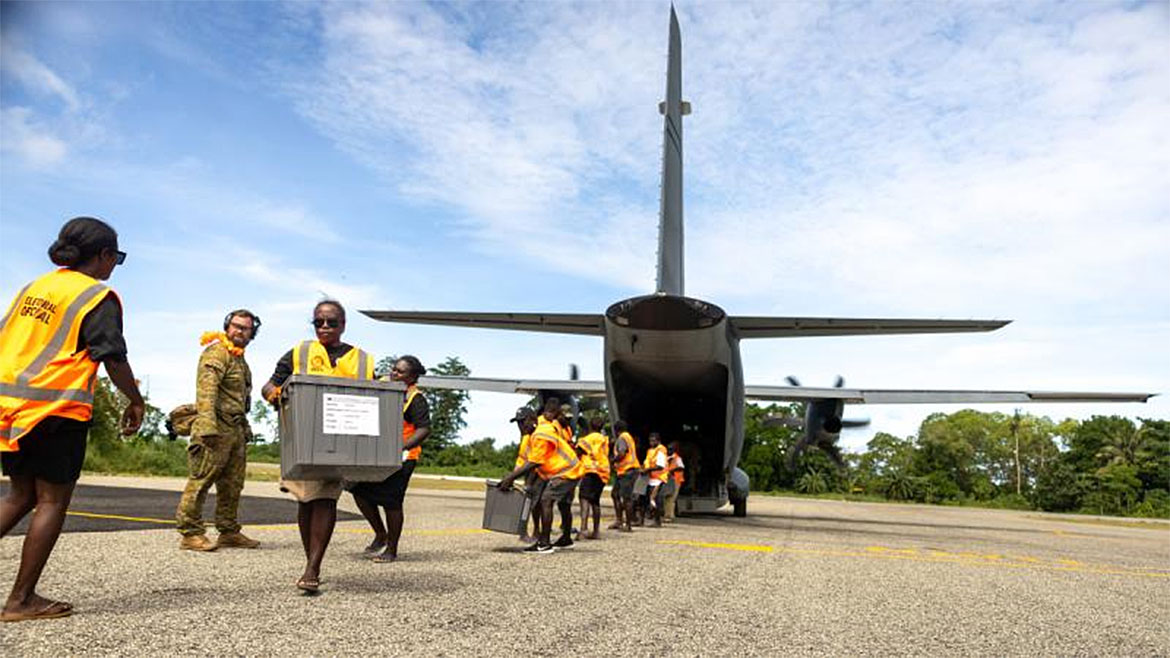
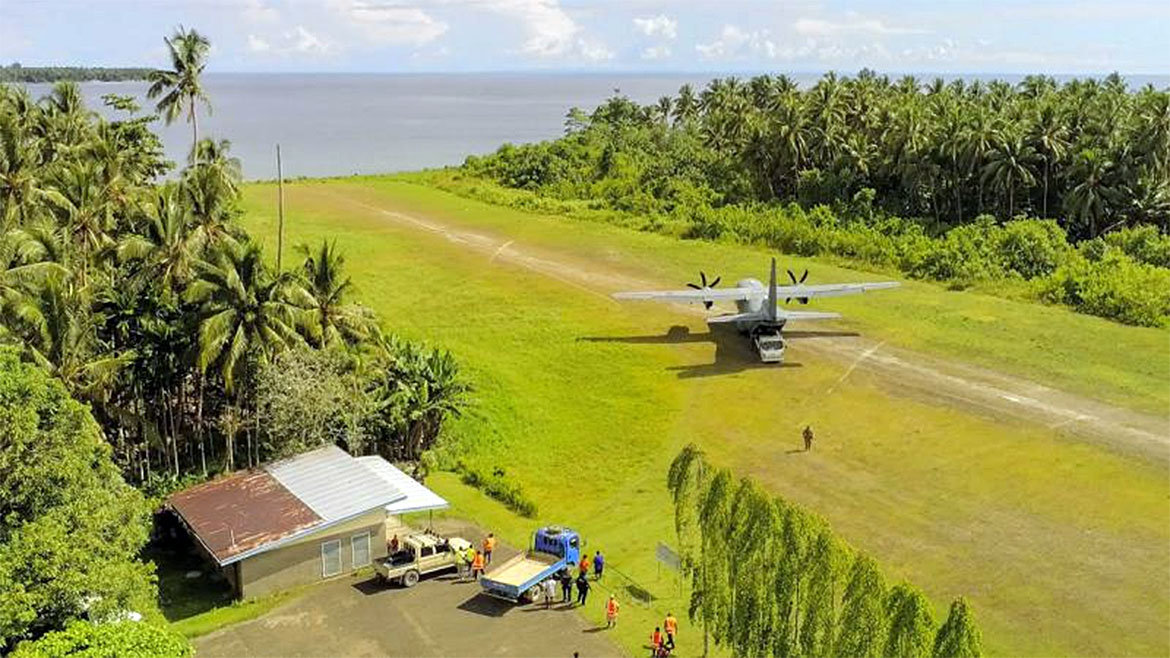
An Air Force C-27J Spartan delivers ballot boxes across the Solomon Islands as a part of the ADF's support to the 2024 elections.
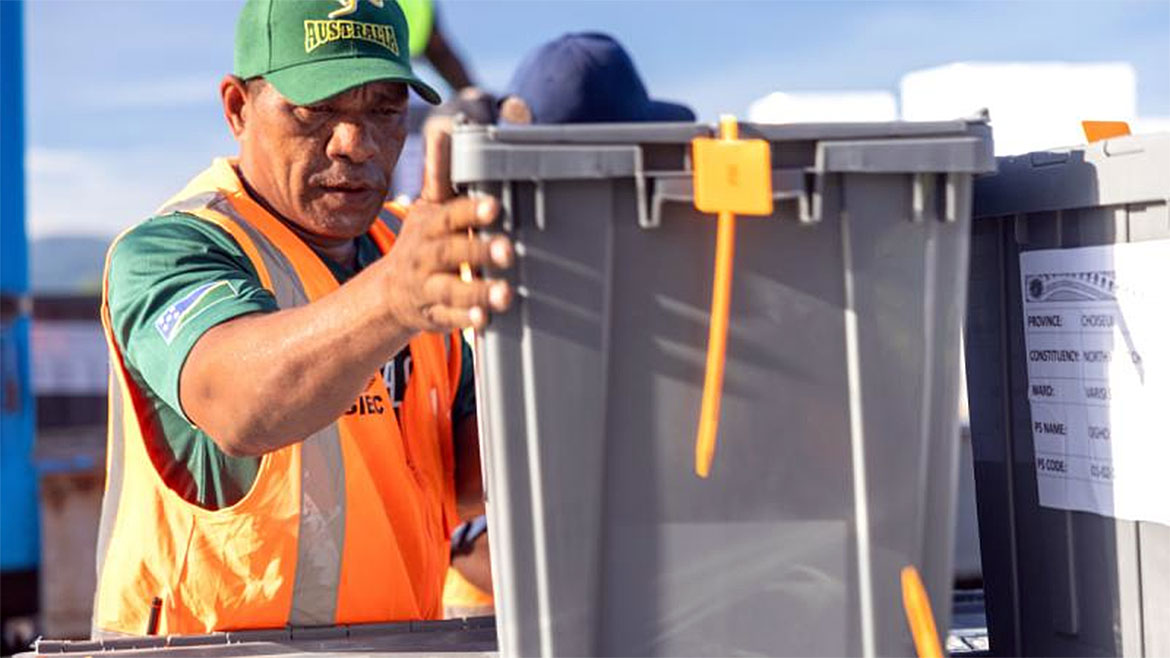
An Electoral Commission member loads a poll box onto a pallet to be delivered to remote areas in the Solomon Islands
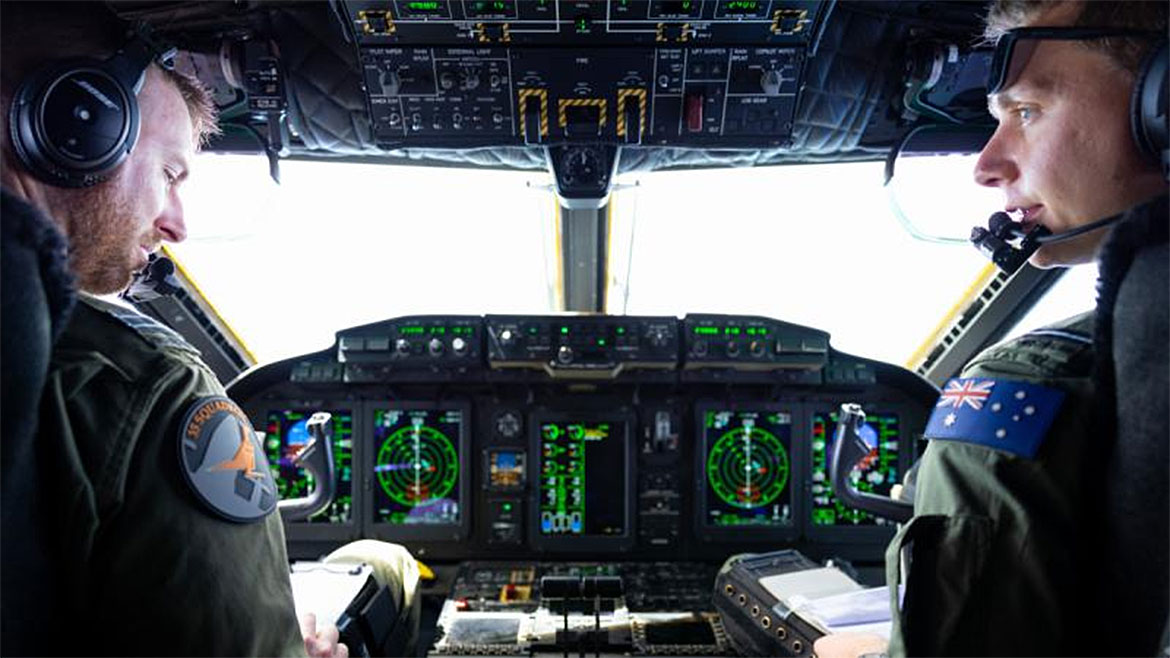
Air Force pilots deployed on Operation Lilia prepare to land a C-27J Spartan to deliver poll boxes to remote areas in the Solomon Islands

From: Terry Jackson, St Albans, Herts
Subject: Visiting Aircraft
Hello Tony,
My experience of ‘visiting aircraft’ is Changi 1971 during the withdrawal from Singapore.
CL44’s, a variation of the Britannia, were sub-contracted to carry loads back to the UK. You will be aware that the aircraft had a ‘swing tail’ that swung open to reveal the interior of the aircraft. The quartermaster came into the office looking like something from ‘Tales of the Gold Monkey’. The conversation went something like this:
"What are you offering?" I asked.
"What have you got?" he replied
"Enough to maximise payload." I said.
"Good," he said, "shove it on."
"How would like it trimmed?" I asked.
"Just put it on, we will sort it out in the air. We have to make a profit, not like you blue jobs!"
Nothing I said would move him from this position. So, the loading crew put the freight on trying to follow some logic in weight distribution. The aircraft had a net in the loading bay that stretched the whole length of the aircraft to hold the freight in place. We had to leave enough room for crew to move down the aircraft. We held our breath as it took off.
We were grateful to see a 99 Squadron Britannia arrive from RAF Lyneham. Life had returned to normal.
Terry
(Editor: Correct me if I'm wrong, but I understand it was impossible to put the Britannia/CL44 out of trim.)
Subject: Visiting Aircraft
Hello Tony,
My experience of ‘visiting aircraft’ is Changi 1971 during the withdrawal from Singapore.
CL44’s, a variation of the Britannia, were sub-contracted to carry loads back to the UK. You will be aware that the aircraft had a ‘swing tail’ that swung open to reveal the interior of the aircraft. The quartermaster came into the office looking like something from ‘Tales of the Gold Monkey’. The conversation went something like this:
"What are you offering?" I asked.
"What have you got?" he replied
"Enough to maximise payload." I said.
"Good," he said, "shove it on."
"How would like it trimmed?" I asked.
"Just put it on, we will sort it out in the air. We have to make a profit, not like you blue jobs!"
Nothing I said would move him from this position. So, the loading crew put the freight on trying to follow some logic in weight distribution. The aircraft had a net in the loading bay that stretched the whole length of the aircraft to hold the freight in place. We had to leave enough room for crew to move down the aircraft. We held our breath as it took off.
We were grateful to see a 99 Squadron Britannia arrive from RAF Lyneham. Life had returned to normal.
Terry
(Editor: Correct me if I'm wrong, but I understand it was impossible to put the Britannia/CL44 out of trim.)


From: David Powell, Princes Risborough, Bucks
Subject: Foreign Air Force Aircraft
Hi Tony,
Thank you for the latest grey cell stirrer, ‘adventures’ involving working with foreign aircraft and air forces. I can offer a couple of memories which might be of interest.
May-June 1965 found me back at a temporary forward strip in Malaysia, close to the Thai border, RAF Gong Kedak. This was the time of the Confrontation with Indonesia. There was a concern that President Sukarno would try a play from the Japanese game book and attempt something from the North. My previous visit had been in January when I had been part of the activation team. The strip then became operational for a three-month deployment of a RAF Germany Canberra sqn. Now, I was back as part of a deactivation team, generated from Singapore RAF stations for a couple of weeks to dismantled the camp we had built 3 months earlier. However, at the last minute, a change of plan by HQ 224 Group, meant that we would remain operational for another two weeks to host a RAAF Canberra squadron while RAF Tengah was having some hard-standings refurbished, before closing the site.
Once the last Canberra had left we began dismantling the camp. During this period our only real contacts with the outside world were the RAAF DC 3 Dakotas which brought in the rations once or twice a week from Butterworth, and RNZAF 41 Sqn Bristol Freighters which operated a weekly resupply of the essential nightly 16mm film shows and the mail. Not exactly a challenging movements task. Once most of the specialists had gone, the residual breakdown team comprised some 3 officers, 25 blokes, a couple of Landrovers and the essential 3-tonner for the daily afternoon R&R run to the beach and or nearby islands. Although, one day I did manage to manifest 13 pax when there were only 12 seats when I went for a couple of days at Butterworth in the cockpit jump-seat. However, as I subsequently discovered, because all RAF flights to Gong Kedak had ended in May, Plan A, the powers that be had pulled out our pin on the HQFEAF map. It wasn’t until the end of June that they discovered that we were still there on a very tranquil Plan B, and that was only after I sent a telegram to HQ 224 Group saying that we were all packed up, and it was really probably time we went back to our units in Singapore. Moreover, there was a train full of tents and camp gear now heading for Singapore! The original Plan A extraction plan was rapidly pulled out of the file, and 3 Beverleys, 2 Argosys and a landing craft for the vehicles turned up the following week. RAF Gong Kedak then returned to just an empty green space in the jungle with a landing strip.
Another ‘foreign air force’ experience came in 1966 with the ending of Confrontation and a 4-week detachment from RAF Changi Supply (aka Equipment or stores) to Queensland’s RAAF Townsville. After a period of work-up and familiarization, three of our 205 Sqn Shackleton MR Mk 2s would be taking part in an extensive UK-Australia-New Zealand air/sea exercise, including competing in the Fincastle Trophy*. Because of the high-level interest in this first major exercise for some years, it was deemed a good idea to have a Mover/Equipper as part of the Shakleton detachment. The reality was that the detachment included a superb logistics team in the shape of the Sqn’s forward store Corporal. Consequently, with everything running smoothly on the supply front, a casual chat the in bar one evening, as you do, and I found myself unofficially attached to the RAAF to go Lea in New Guinea for a few days. It appeared that the Australians were a bit short of a movements officer to handle their C130’s undertaking the deployment and recovery of the support for a detachment of RAAF P2 Neptunes from RAAF Townsville. This meant a fascinating ride across the Coral Sea in the first Neptune to Lea, to be there to help set up arrangements with the Civil Airport Manager for when the C130s arrived.
Prior to deploying to Lea, my new colleagues thought it would be a good idea if I had a ‘check ride’ as their mover on an element of the exercise which involved 3 RAAF C130s deploying some Neptune squadron support down to RAAF Richmond near Sydney. This included an overnight stay on the base. The day went well and my trip to Lea was secured. In the evening, I decided that a stroll before dinner might be a good idea.
Subject: Foreign Air Force Aircraft
Hi Tony,
Thank you for the latest grey cell stirrer, ‘adventures’ involving working with foreign aircraft and air forces. I can offer a couple of memories which might be of interest.
May-June 1965 found me back at a temporary forward strip in Malaysia, close to the Thai border, RAF Gong Kedak. This was the time of the Confrontation with Indonesia. There was a concern that President Sukarno would try a play from the Japanese game book and attempt something from the North. My previous visit had been in January when I had been part of the activation team. The strip then became operational for a three-month deployment of a RAF Germany Canberra sqn. Now, I was back as part of a deactivation team, generated from Singapore RAF stations for a couple of weeks to dismantled the camp we had built 3 months earlier. However, at the last minute, a change of plan by HQ 224 Group, meant that we would remain operational for another two weeks to host a RAAF Canberra squadron while RAF Tengah was having some hard-standings refurbished, before closing the site.
Once the last Canberra had left we began dismantling the camp. During this period our only real contacts with the outside world were the RAAF DC 3 Dakotas which brought in the rations once or twice a week from Butterworth, and RNZAF 41 Sqn Bristol Freighters which operated a weekly resupply of the essential nightly 16mm film shows and the mail. Not exactly a challenging movements task. Once most of the specialists had gone, the residual breakdown team comprised some 3 officers, 25 blokes, a couple of Landrovers and the essential 3-tonner for the daily afternoon R&R run to the beach and or nearby islands. Although, one day I did manage to manifest 13 pax when there were only 12 seats when I went for a couple of days at Butterworth in the cockpit jump-seat. However, as I subsequently discovered, because all RAF flights to Gong Kedak had ended in May, Plan A, the powers that be had pulled out our pin on the HQFEAF map. It wasn’t until the end of June that they discovered that we were still there on a very tranquil Plan B, and that was only after I sent a telegram to HQ 224 Group saying that we were all packed up, and it was really probably time we went back to our units in Singapore. Moreover, there was a train full of tents and camp gear now heading for Singapore! The original Plan A extraction plan was rapidly pulled out of the file, and 3 Beverleys, 2 Argosys and a landing craft for the vehicles turned up the following week. RAF Gong Kedak then returned to just an empty green space in the jungle with a landing strip.
Another ‘foreign air force’ experience came in 1966 with the ending of Confrontation and a 4-week detachment from RAF Changi Supply (aka Equipment or stores) to Queensland’s RAAF Townsville. After a period of work-up and familiarization, three of our 205 Sqn Shackleton MR Mk 2s would be taking part in an extensive UK-Australia-New Zealand air/sea exercise, including competing in the Fincastle Trophy*. Because of the high-level interest in this first major exercise for some years, it was deemed a good idea to have a Mover/Equipper as part of the Shakleton detachment. The reality was that the detachment included a superb logistics team in the shape of the Sqn’s forward store Corporal. Consequently, with everything running smoothly on the supply front, a casual chat the in bar one evening, as you do, and I found myself unofficially attached to the RAAF to go Lea in New Guinea for a few days. It appeared that the Australians were a bit short of a movements officer to handle their C130’s undertaking the deployment and recovery of the support for a detachment of RAAF P2 Neptunes from RAAF Townsville. This meant a fascinating ride across the Coral Sea in the first Neptune to Lea, to be there to help set up arrangements with the Civil Airport Manager for when the C130s arrived.
Prior to deploying to Lea, my new colleagues thought it would be a good idea if I had a ‘check ride’ as their mover on an element of the exercise which involved 3 RAAF C130s deploying some Neptune squadron support down to RAAF Richmond near Sydney. This included an overnight stay on the base. The day went well and my trip to Lea was secured. In the evening, I decided that a stroll before dinner might be a good idea.

While strolling across the fields, a very attractive young lady waved to me. I immediately altered course to intercept to find out: a) it was the base commander’s daughter, b) she was a bit short sighted c) had left her glasses behind and d) thought I was someone else, hence the waving. Anyway, a pleasant conversation ensued during which she suggested that I might like to accompany her into the nearby eucalyptus grove, to see her Koalas (Editor: Is that what they called them back then?). It was there that I learned that, if underneath, to move slowly as creating excitement can result in being piddled on (by the Koala bears up in the trees!).
Best Wishes
David Powell UKMAMS Abingdon 1967-69
Best Wishes
David Powell UKMAMS Abingdon 1967-69
*Fincastle Trophy: The Fincastle Competition began in 1960 when Mr. and Mrs. Aird-Whyte presented a silver tray, the Fincastle Trophy, in memory of their son Sergeant Nairn Fincastle Aird-Whyte, KIA in 1943 while serving with RAF Coastal Command. Initially competed for by RAF, RAAF, RCAF and RNZAF Maritime Air for accuracy in depth charge bombing. 205 Sqn were the winners that year.


A new member who has joined us recently:
Welcome to the OBA!
Errol Reidlinger, Walloon, QLD

Kiwi veterans mark more than 30 years since Somalia deployment
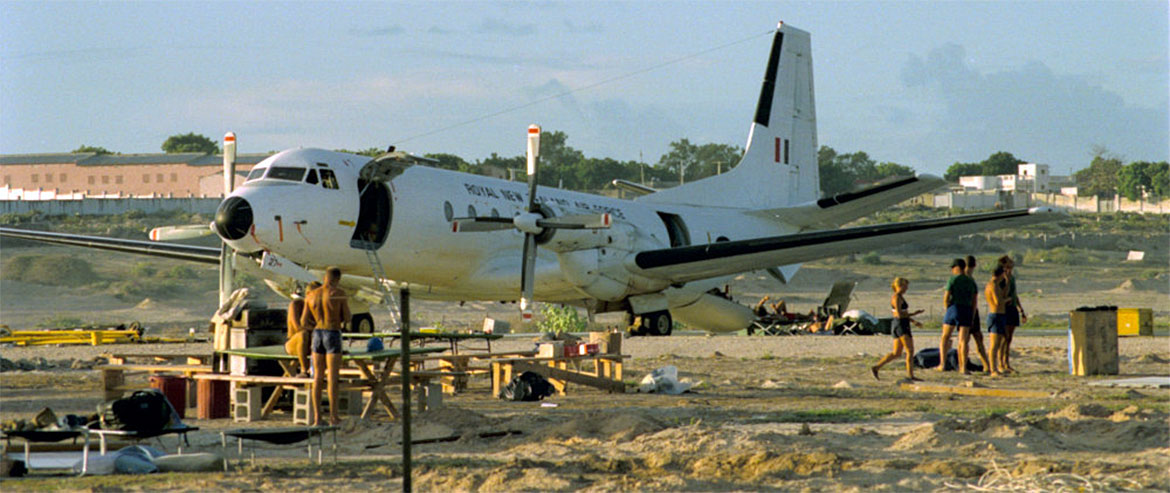
In 1993, three Royal New Zealand Air Force (RNZAF) Andover transport aircraft and their crews from No. 42 Squadron were deployed to Mogadishu, Somalia. The 62-strong RNZAF contingent formed part of the multi-national effort to protect food aid convoys from Somali warlords. During their five-month deployment, 233 missions were flown, carrying supplies and transporting personnel in and out of Mogadishu.
The New Zealand Army's involvement began in 1992 with the deployment of a 28-personnel supply detachment as part of the original United Nations operation in Somalia. Its primary responsibility was to provide supplies to the UN Force.
In July 1993, due to the deteriorating situation on the ground, the detachment was replaced by a 43-personnel supply platoon, which included an infantry section from the 1st Battalion, Royal New Zealand Infantry Regiment. This deployment marked the first time since the Vietnam War that New Zealand infantry had been deployed to a war zone.
More than three decades on, around 70 New Zealand veterans of the UN peacekeeping operation in Somalia have reunited in Wellington. They were welcomed to Defence House on Tuesday with a pōwhiri hosted by the Deputy Chief of Air Force, Air Commodore Daniel Hunt, and also attended by the head of Veterans’ Affairs, Bernadine MacKenzie. One of the organisers, Dean Groves, said the reunion was an opportunity to ensure the efforts of air force and army personnel on this deployment are remembered. “The Kiwi personnel in Mogadishu played a vital role in a challenging conflict and earned significant respect from their international peers.”
The New Zealand deployment operated from what was known as Taniwha Hill camp, nestled on a large sand dune between the Indian Ocean and Mogadishu Airport. The platoon witnessed the Battle of Mogadishu, including the infamous 'Black Hawk Down' incident.
Mr Groves said the conditions were challenging and dangerous but the Kiwi troops persevered, often contending with inadequate equipment and facing constant threats from Somali bandits. “The New Zealand troops were only issued with small arms and fragmentation vests, which were inadequate for the threat level. They drove commercial vehicles with little protection against the power of improvised explosive devices. “Their primary weapon was speed, as the Somalis were often under the influence of the hallucinatory herbal drug known as khat. Sometimes, the situation deteriorated to a point where all driving was curtailed,” he said.
Helicopters had to be used to fly to United Nations locations around Mogadishu. Gunfire was constant and sometimes Somali bandits would climb into the surrounding buildings and fire into the airfield and seaport, where the Kiwis were based, and taking sporadic pot shots. Personnel also came under mortar fire.
Mr Groves said the reunion provided a chance for reflection and to enjoy the camaraderie between old colleagues.Some of those who attended the reunion also took part in a wreath-laying ceremony at Pukeahu National War Memorial Park last week alongside Australian Governor-General David Hurley - himself a Somali deployment veteran, who invited six New Zealand veterans to attend a state dinner.
On Anzac Day, the New Zealand veterans were joined by a small group of their Australian counterparts to pay their respects and lay a wreath at the Dawn Service at Pukeahu National War Memorial Park.
nzdf.mil.nz
The New Zealand Army's involvement began in 1992 with the deployment of a 28-personnel supply detachment as part of the original United Nations operation in Somalia. Its primary responsibility was to provide supplies to the UN Force.
In July 1993, due to the deteriorating situation on the ground, the detachment was replaced by a 43-personnel supply platoon, which included an infantry section from the 1st Battalion, Royal New Zealand Infantry Regiment. This deployment marked the first time since the Vietnam War that New Zealand infantry had been deployed to a war zone.
More than three decades on, around 70 New Zealand veterans of the UN peacekeeping operation in Somalia have reunited in Wellington. They were welcomed to Defence House on Tuesday with a pōwhiri hosted by the Deputy Chief of Air Force, Air Commodore Daniel Hunt, and also attended by the head of Veterans’ Affairs, Bernadine MacKenzie. One of the organisers, Dean Groves, said the reunion was an opportunity to ensure the efforts of air force and army personnel on this deployment are remembered. “The Kiwi personnel in Mogadishu played a vital role in a challenging conflict and earned significant respect from their international peers.”
The New Zealand deployment operated from what was known as Taniwha Hill camp, nestled on a large sand dune between the Indian Ocean and Mogadishu Airport. The platoon witnessed the Battle of Mogadishu, including the infamous 'Black Hawk Down' incident.
Mr Groves said the conditions were challenging and dangerous but the Kiwi troops persevered, often contending with inadequate equipment and facing constant threats from Somali bandits. “The New Zealand troops were only issued with small arms and fragmentation vests, which were inadequate for the threat level. They drove commercial vehicles with little protection against the power of improvised explosive devices. “Their primary weapon was speed, as the Somalis were often under the influence of the hallucinatory herbal drug known as khat. Sometimes, the situation deteriorated to a point where all driving was curtailed,” he said.
Helicopters had to be used to fly to United Nations locations around Mogadishu. Gunfire was constant and sometimes Somali bandits would climb into the surrounding buildings and fire into the airfield and seaport, where the Kiwis were based, and taking sporadic pot shots. Personnel also came under mortar fire.
Mr Groves said the reunion provided a chance for reflection and to enjoy the camaraderie between old colleagues.Some of those who attended the reunion also took part in a wreath-laying ceremony at Pukeahu National War Memorial Park last week alongside Australian Governor-General David Hurley - himself a Somali deployment veteran, who invited six New Zealand veterans to attend a state dinner.
On Anzac Day, the New Zealand veterans were joined by a small group of their Australian counterparts to pay their respects and lay a wreath at the Dawn Service at Pukeahu National War Memorial Park.
nzdf.mil.nz
From: Clive Price, Brecon
Subject: Visiting Aircraft
Hi Tony,
We had to be at an East England airfield by midnight. We arrived on time and were greeted by some Douglas DC-3 Dakotas landing. They had no national markings and by daylight they were all loaded and gone. The loads were all tank ammo. Who knows who they were for, but two weeks later things kicked-off in the Middle East - your guess is as good as mine!
Taff Price
F team, Abingdon, 1966/70
Subject: Visiting Aircraft
Hi Tony,
We had to be at an East England airfield by midnight. We arrived on time and were greeted by some Douglas DC-3 Dakotas landing. They had no national markings and by daylight they were all loaded and gone. The loads were all tank ammo. Who knows who they were for, but two weeks later things kicked-off in the Middle East - your guess is as good as mine!
Taff Price
F team, Abingdon, 1966/70


From: Gerry Davis, Bedminster, Glos
Subject: Visiting Aircraft
Tony,
RAF Lyneham during my time there, 1968 /1971, was a very busy transport base. We had other air forces pay us regular visits, together with many civilian Ministry of Defence chartered aircraft. I can recall one of these operated by ‘Monarch Airline’s a Bristol Britannia 312 series aircraft GAOVT, a reasonably frequent visitor. Unlike our Britannia’s, this aircraft had a wooden floor.
This one time it came in from its base at Luton airport empty for a cargo charter; it had a crew of three, one of whom, an ex-Air Mover, had just been demobbed from RAF Lyneham and was the aircraft’s Loadmaster. His old shift, which he had been the corpora, was on duty. The Flt/Sgt in charge of the loaders never got on with this lad when he served here and the two of them clashed right away. Incidentally this aircraft had come in without sufficient tie-down and lashing equipment. There was an almighty row over this, with this ex-corporal trying to flex his muscles within his new job, which of course had not the slightest effect on any of us or indeed the Flt/Sgt.
Eventually a consignment of the necessary lashing gear was loaned to this individual, naming him responsible for its safe keeping and return. All the cargo was eventually placed on the aircraft leaving the bright new boy to see to it. As a result of this incident the powers that be contacted ‘Monarch’ to let them know that in future this individual was persona non grata. We later heard that he was ‘let go.’
Subject: Visiting Aircraft
Tony,
RAF Lyneham during my time there, 1968 /1971, was a very busy transport base. We had other air forces pay us regular visits, together with many civilian Ministry of Defence chartered aircraft. I can recall one of these operated by ‘Monarch Airline’s a Bristol Britannia 312 series aircraft GAOVT, a reasonably frequent visitor. Unlike our Britannia’s, this aircraft had a wooden floor.
This one time it came in from its base at Luton airport empty for a cargo charter; it had a crew of three, one of whom, an ex-Air Mover, had just been demobbed from RAF Lyneham and was the aircraft’s Loadmaster. His old shift, which he had been the corpora, was on duty. The Flt/Sgt in charge of the loaders never got on with this lad when he served here and the two of them clashed right away. Incidentally this aircraft had come in without sufficient tie-down and lashing equipment. There was an almighty row over this, with this ex-corporal trying to flex his muscles within his new job, which of course had not the slightest effect on any of us or indeed the Flt/Sgt.
Eventually a consignment of the necessary lashing gear was loaned to this individual, naming him responsible for its safe keeping and return. All the cargo was eventually placed on the aircraft leaving the bright new boy to see to it. As a result of this incident the powers that be contacted ‘Monarch’ to let them know that in future this individual was persona non grata. We later heard that he was ‘let go.’


A Monarch Airlines Bristol Britannia - these had wooden floors, unlike the RAF Britannia's that were all metal
I also recall an Ace Freighter L749 Constellation, landing at Lyneham for a one-way charter. It taxied in and shut down its engines and oil oozed onto the newly cocreated apron. Drip trays were provided to collect most of it. This surprisingly upset the Station Commander who ordered us movers to load the aircraft and get it away ASAP. It also arrived without sufficient lashing equipment. I took the Loadmaster down to the NAAFI shop where he bought two clothes lines.
It was also interesting to note that the engine cowlings had locking wire fastened around each engine to keep them shut. There again the cargo was placed on the aircraft and left to the loadmaster to sort it.
It was also interesting to note that the engine cowlings had locking wire fastened around each engine to keep them shut. There again the cargo was placed on the aircraft and left to the loadmaster to sort it.
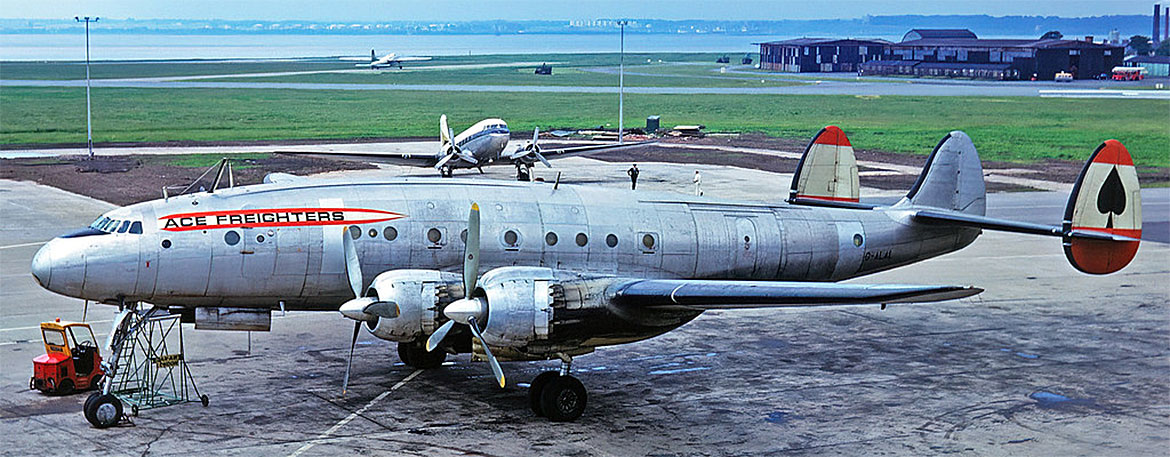
An Ace Freighter Constellation - not a very welcome visitor with her leaking copious amounts of oil

From: Brian Carlin, San Diego, CA
Subject: Visiting Aircraft
Hi Tony,
You may recall that I was an Elec. Tech. Air and not a Movements guy, but I have a little contribution to offer about a visiting aircraft.
While stationed at RAF Labuan, Borneo, in 1967, part of my job was seeing in visiting aircraft. One of these was a Cambodian Military C47 (Dakota). As soon as we groundcrew members marshaled it to a parking spot and gave the pilot the halt signal, the cargo door opened and a crew member jumped out carrying a set of undercarriage groundlocks, all the while the pilot kept both engines running. The crew member hurriedly installed the locks on the undercarriage legs and then indicated to the pilot that he had done so. Only then were the engines shut down.
Later, when we saw the C47 off, it was the reverse procedure - the engines were started and run up to speed before the groundlocks were removed. I found out later that this particular aircraft was a frequent visitor to Labuan and that its hydraulic system was so leaky that if the engines, which also drive the hydraulic pumps, had been shut down prior to the groundlocks being installed, in all likelihood the undercarriage would have collapsed!
Regards,
Brian Carlin
Subject: Visiting Aircraft
Hi Tony,
You may recall that I was an Elec. Tech. Air and not a Movements guy, but I have a little contribution to offer about a visiting aircraft.
While stationed at RAF Labuan, Borneo, in 1967, part of my job was seeing in visiting aircraft. One of these was a Cambodian Military C47 (Dakota). As soon as we groundcrew members marshaled it to a parking spot and gave the pilot the halt signal, the cargo door opened and a crew member jumped out carrying a set of undercarriage groundlocks, all the while the pilot kept both engines running. The crew member hurriedly installed the locks on the undercarriage legs and then indicated to the pilot that he had done so. Only then were the engines shut down.
Later, when we saw the C47 off, it was the reverse procedure - the engines were started and run up to speed before the groundlocks were removed. I found out later that this particular aircraft was a frequent visitor to Labuan and that its hydraulic system was so leaky that if the engines, which also drive the hydraulic pumps, had been shut down prior to the groundlocks being installed, in all likelihood the undercarriage would have collapsed!
Regards,
Brian Carlin


From: Norman Stamper, Torrevieja
Subject: Re: UKMAMS OBA OBB #033124
Hi Tony,
Thanks for this month's newsletter. I always dread the last item, familiar names who are no longer with us. I've attached a photo of the RAF Wildenrath Movements staff taken in October 1985 outside the old Terminal, sadly no longer there. Last time I saw it, it had changed into a train testing track that ran all around the camp. As you can see the photo not only has the latest casualties, John Chambers and Troop Smith, but also Alan Scarisbrick, Dixie Dean, Mick Mylchreest and Spike Maris.
Thanks for keeping us all in touch with what's going on in the Movements world. Hasn't it changed a lot!
All the best
Norman
Subject: Re: UKMAMS OBA OBB #033124
Hi Tony,
Thanks for this month's newsletter. I always dread the last item, familiar names who are no longer with us. I've attached a photo of the RAF Wildenrath Movements staff taken in October 1985 outside the old Terminal, sadly no longer there. Last time I saw it, it had changed into a train testing track that ran all around the camp. As you can see the photo not only has the latest casualties, John Chambers and Troop Smith, but also Alan Scarisbrick, Dixie Dean, Mick Mylchreest and Spike Maris.
Thanks for keeping us all in touch with what's going on in the Movements world. Hasn't it changed a lot!
All the best
Norman
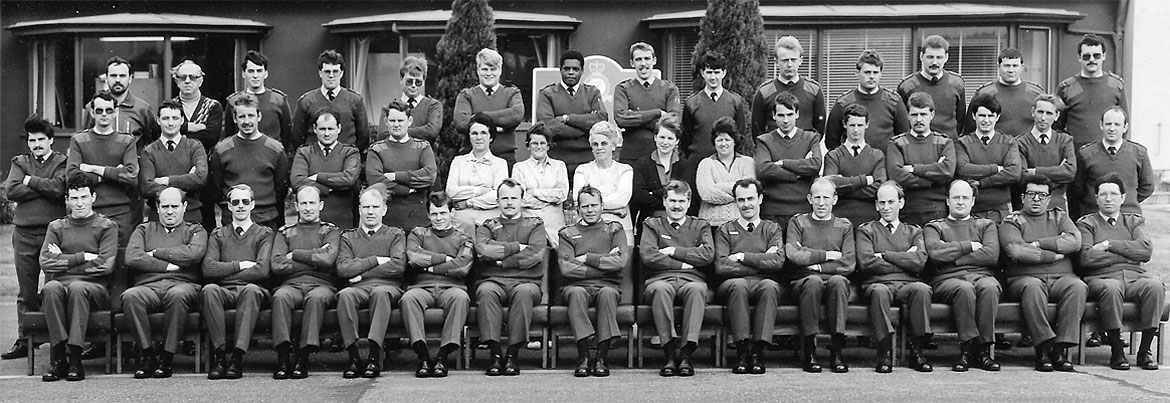



From: Dougie Russell, Carlilse
Subject: Visiting Aircraft
Hi Tony,
Whilst I never served on shift at Lyneham, my dealings with foreign aircraft have been at Brize Norton, Wildenrath and Bardufoss. Most memorable was a certain VC10 that belonged to the Sultan of Oman.
We loaded white goods (washing machines etc., into holds 10 and 11) before we got a sneak peak upstairs… Wow! How the other half live! Gold taps in a proper bathroom on board. King size double bed with purple velvet covers. It was a flying palace!
Another interesting one were certain Boeing 707's where we loaded gold bars on one under the watchful eyes of a number of armed guards... we loaded the second Boeing 707 at the other end of the runway with boxes of special paper for printing money. Needless to say both aircraft came from different countries in the Middle East.
Happy days,
Dougie
Subject: Visiting Aircraft
Hi Tony,
Whilst I never served on shift at Lyneham, my dealings with foreign aircraft have been at Brize Norton, Wildenrath and Bardufoss. Most memorable was a certain VC10 that belonged to the Sultan of Oman.
We loaded white goods (washing machines etc., into holds 10 and 11) before we got a sneak peak upstairs… Wow! How the other half live! Gold taps in a proper bathroom on board. King size double bed with purple velvet covers. It was a flying palace!
Another interesting one were certain Boeing 707's where we loaded gold bars on one under the watchful eyes of a number of armed guards... we loaded the second Boeing 707 at the other end of the runway with boxes of special paper for printing money. Needless to say both aircraft came from different countries in the Middle East.
Happy days,
Dougie


From: Dave Green, Huntingdon, Cambs
Subject: Visiting Aircraft
Hi Tony,
I was in Belize in 1983 and every year a Canadian who owns the bulk of the mango fields in Belize hires in a fleet of aircraft to export his crop through Miami. In '83 this consisted of 4 DC-6 freighters. 3 went u/s on arrival and sat around for the best part of a week awaiting spares. The first was loaded by some local guys with a 6k forklift that didn't have any brakes. Bags of mangoes were loaded onto an open hopper on the tines and the forklift was driven at the aircraft. A delicately placed log provided the braking action and a marker for the driver to tip the load of mangoes into the freight door. Conformal loading was the order of the day filling the aircraft with mangoes and a single net was strung across the fuselage when was loading was complete.
I spoke to the lead Loadmaster before the aircraft departed and asked what weight they were taking, He said he thought around 40k lbs at which I stated we didn't get that on a Herc out of Belize (long time ago, my figures might be slightly out but you get my drift). He said we'll 'suck it and see' with the first load out. The aircraft taxied out to the end of the runway and staggered off just clearing the trees at the end of the bondu. The lead Loadie said he was glad he wasn't on the aircraft and said he thought maybe 10k lbs less for the remaining flights out! Load planning is obviously overhyped.
Rgds
Dave Green
Subject: Visiting Aircraft
Hi Tony,
I was in Belize in 1983 and every year a Canadian who owns the bulk of the mango fields in Belize hires in a fleet of aircraft to export his crop through Miami. In '83 this consisted of 4 DC-6 freighters. 3 went u/s on arrival and sat around for the best part of a week awaiting spares. The first was loaded by some local guys with a 6k forklift that didn't have any brakes. Bags of mangoes were loaded onto an open hopper on the tines and the forklift was driven at the aircraft. A delicately placed log provided the braking action and a marker for the driver to tip the load of mangoes into the freight door. Conformal loading was the order of the day filling the aircraft with mangoes and a single net was strung across the fuselage when was loading was complete.
I spoke to the lead Loadmaster before the aircraft departed and asked what weight they were taking, He said he thought around 40k lbs at which I stated we didn't get that on a Herc out of Belize (long time ago, my figures might be slightly out but you get my drift). He said we'll 'suck it and see' with the first load out. The aircraft taxied out to the end of the runway and staggered off just clearing the trees at the end of the bondu. The lead Loadie said he was glad he wasn't on the aircraft and said he thought maybe 10k lbs less for the remaining flights out! Load planning is obviously overhyped.
Rgds
Dave Green

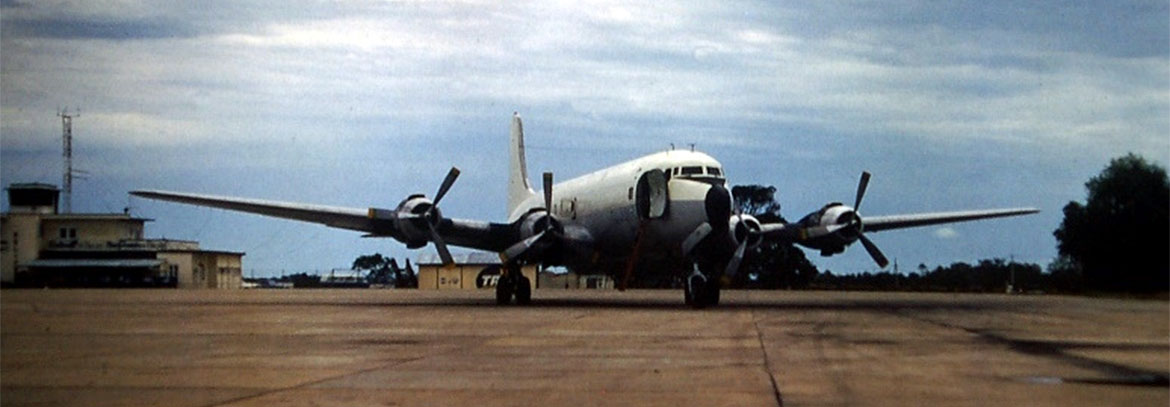
DC-6 freighter - carrying mangoes from Belize to Miami

From: Jacques Guay, North Port, FL
Subject: Visiting Aircraft
Hello Tony:
The year was, I think, 1973. CFB Trenton was preparing to host an air show and military aircraft were coming from the US. There was an F-15 amongst others which, I believe, was brand new at the time.
A few hours later, while working on a C130, a howl was heard coming in closer to the base. I just had to take a look to find out what in the heavens was coming in. Well, it was a Vulcan bomber. One of the most impressive aircraft I had ever seen in my life. Nothing else like it. After it was parked, I just had to get a look inside. Curiosity got the better of me. I asked the RAF crew member if I could take a look. He told me to go and have a look.
Since there was no GPU attached for power, it was dark inside. Just two tiny windows below the flight deck. I found it very claustrophobic for such a huge aircraft. Then I proceeded to the cockpit. That "office" was very cramped. I checked out the pilots' windows. I don't know to this day how anyone could see outside of those small windows.
I had seen and flown on other large and small aircraft before, but nothing had prepared me for such a cramped crew space. I don't know if they had a "head" on board or not, but flying all the way from the UK in that space, OY!
Jacques
Subject: Visiting Aircraft
Hello Tony:
The year was, I think, 1973. CFB Trenton was preparing to host an air show and military aircraft were coming from the US. There was an F-15 amongst others which, I believe, was brand new at the time.
A few hours later, while working on a C130, a howl was heard coming in closer to the base. I just had to take a look to find out what in the heavens was coming in. Well, it was a Vulcan bomber. One of the most impressive aircraft I had ever seen in my life. Nothing else like it. After it was parked, I just had to get a look inside. Curiosity got the better of me. I asked the RAF crew member if I could take a look. He told me to go and have a look.
Since there was no GPU attached for power, it was dark inside. Just two tiny windows below the flight deck. I found it very claustrophobic for such a huge aircraft. Then I proceeded to the cockpit. That "office" was very cramped. I checked out the pilots' windows. I don't know to this day how anyone could see outside of those small windows.
I had seen and flown on other large and small aircraft before, but nothing had prepared me for such a cramped crew space. I don't know if they had a "head" on board or not, but flying all the way from the UK in that space, OY!
Jacques


From: Eddie Hewitt, Hoylandswaine, South Yorks
Subject: RAF Seletar
Hi Tony,
Bit of a random one... I picked up a big 'ol hardback book in a secondhand shop called "Down the Seletar River", not really knowing what it was about.
Anyway, loads in there about the RAF base - including a handwritten message at front.
I must confess I hadn't even heard of RAF Seletar, and don't know if any Movers were ever stationed there?
If the book is of interest to anybody, I only paid £2.50 for it - so would be happy to post to somebody. It is in great condition.
Cheers
Eddie
(To send an e-mail to Eddie, just click on the flags next to his name above)
Subject: RAF Seletar
Hi Tony,
Bit of a random one... I picked up a big 'ol hardback book in a secondhand shop called "Down the Seletar River", not really knowing what it was about.
Anyway, loads in there about the RAF base - including a handwritten message at front.
I must confess I hadn't even heard of RAF Seletar, and don't know if any Movers were ever stationed there?
If the book is of interest to anybody, I only paid £2.50 for it - so would be happy to post to somebody. It is in great condition.
Cheers
Eddie
(To send an e-mail to Eddie, just click on the flags next to his name above)


From: Stephen Davey, Tadcaster, North Yorks
Subject: Visiting Aircraft
Tony,
This subject brings to mind the occasion when I was at Brize Norton in 1973 we came on shift in the afternoon and were greeted by the sight of a CL-44 on the pan outside the Air Movements hangar. I think the aircraft belonged to Cargolux (if my memory serves me right), the loadmaster was an ex RAF mover who knew some of the team and the load was humanitarian aid for refugees in an ongoing conflict somewhere or other. The load consisted of hundreds of small individual boxes which took an age to load but load it we did and the aircraft departed on time for a destination of which I have not a scoobies!
Regards, Steve Davey
Subject: Visiting Aircraft
Tony,
This subject brings to mind the occasion when I was at Brize Norton in 1973 we came on shift in the afternoon and were greeted by the sight of a CL-44 on the pan outside the Air Movements hangar. I think the aircraft belonged to Cargolux (if my memory serves me right), the loadmaster was an ex RAF mover who knew some of the team and the load was humanitarian aid for refugees in an ongoing conflict somewhere or other. The load consisted of hundreds of small individual boxes which took an age to load but load it we did and the aircraft departed on time for a destination of which I have not a scoobies!
Regards, Steve Davey


From: Ian Berry, Eastleaze, Swindon, Wilts
Subject: Visiting Aircraft
Hi Tony,
Subject: Visiting Aircraft
Hi Tony,

Ilyushin 76 (IL76) – First ever visit to the West...
(This item was originally written for a civilian aircraft enthusiasts' newsletter)
(This item was originally written for a civilian aircraft enthusiasts' newsletter)
In 1981, the Cold War, East against West, was still continuing with no sign of it ending. Who could imagine that within a few months we would be at war with Argentina over the Falkland Islands.
In November that year I was a Flight Sergeant MAMS Team Leader based at RAF Lyneham. I had just been given a task at RAF Manston, Kent, but the information was sparse. In fact I was told to attend the station for a briefing. On arrival at the venue, I was introduced to the other attendees. These included the Station Ops Officer, a senior policeman from the Kent Police, a Customs and Immigration Officer and two gentlemen from ‘Military Intelligence’.
Later that month a Soviet built Ilyushin 76 (IL76) operated by the Syrians was due to land at Manston to collect two loads of ex-MOD hardware which they had purchased. Although being built from the mid-1970s, none of these aircraft had ever landed in the ‘West’. 200 of this type alone were operated by the Russian Air Force. This was potentially quite a coup for the Intelligence Services as they wanted to ‘glean’ all they could concerning this aircraft. It had the NATO code name CANDID.
In November that year I was a Flight Sergeant MAMS Team Leader based at RAF Lyneham. I had just been given a task at RAF Manston, Kent, but the information was sparse. In fact I was told to attend the station for a briefing. On arrival at the venue, I was introduced to the other attendees. These included the Station Ops Officer, a senior policeman from the Kent Police, a Customs and Immigration Officer and two gentlemen from ‘Military Intelligence’.
Later that month a Soviet built Ilyushin 76 (IL76) operated by the Syrians was due to land at Manston to collect two loads of ex-MOD hardware which they had purchased. Although being built from the mid-1970s, none of these aircraft had ever landed in the ‘West’. 200 of this type alone were operated by the Russian Air Force. This was potentially quite a coup for the Intelligence Services as they wanted to ‘glean’ all they could concerning this aircraft. It had the NATO code name CANDID.
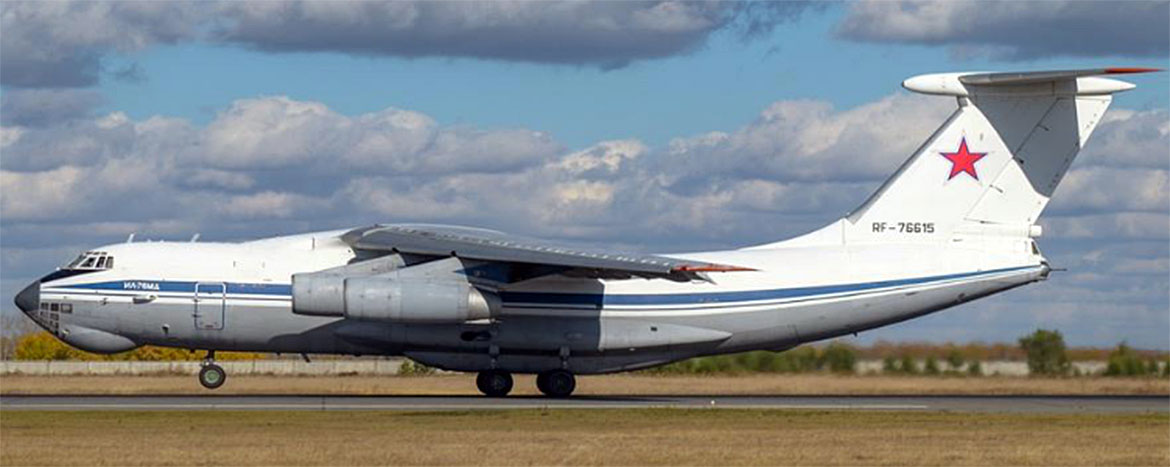
Ilyushin 76M of the Russian Air Force
The ‘spooks’ explained that they would need some time with no hindrance to look at the flight deck, make measurements and calculations whilst taking photographs and making notes. They also asked if I could provide a set of Nomex coveralls that we used with a name tag so that one of them could mingle with the team. This was because we alone would have full access without arousing suspicion. We did not know at this time if the crew would be purely Syrian or whether there would be any other nationalities amongst them.
A plot was hatched and it was decided that once the aircraft had arrived and post-flight checks carried out that ALL the crew would be taken to Ramsgate for arrival procedures. No protests would be entertained. I then needed to know what the actual cargo was going to be so as to decide what loading aids would be required. The cargo in fact was to be wheeled units, now army surplus and known as Giant Viper.
A plot was hatched and it was decided that once the aircraft had arrived and post-flight checks carried out that ALL the crew would be taken to Ramsgate for arrival procedures. No protests would be entertained. I then needed to know what the actual cargo was going to be so as to decide what loading aids would be required. The cargo in fact was to be wheeled units, now army surplus and known as Giant Viper.

Giant Viper Mine Clearance Unit
Giant Viper towed by a Centurion Tank
The Giant Viper was mine clearance system designed in the 1950s. It consisted of a large two wheeled trailer containing a substantial amount of explosives inside a 250mtr long tube. At the rear of the trailer was an angled rocket launcher which would be used to deliver the tubing into a suspected minefield. The system was originally designed to be towed behind either a Centurion tank, a 432 Armoured Personnel Carrier or an AVRE (Armoured Vehicle Royal Engineers). When fired the projectile and explosive tubing would go over the armoured vehicle and land ahead in the minefield, detonating almost instantaneously and creating a 200mtr long 6mtr wide channel. This piece of equipment was in front line service until the end of the 1970s when it was replaced by a similar system known as Python. (When the MOD contractors delivered the equipment to us at Manston they said that during the demonstration on the MOD Ranges for the Syrians all did not go to plan. When the Giant Viper was fired there was quite a lot of wind blowing and the system drifted off and landed in a wood. The following explosion made a huge clearing in the trees – suitably impressed they immediately ordered 12 units.)
Prior to the task I made a second trip to RAF Manston to meet the same parties and confirm the plan of action. One of the ‘spooks’ would be lying on his back with cameras for the approach of the IL76, this was so that they could look at the undercarriage configuration in slow time and also see what else was under there not always accessible when the aircraft was on the ground. I also handed over a set of coveralls bearing the name ‘Dave Wright’ who was also 6ft tall to be used by the other chap (sadly Dave has now passed away). Accommodation on the Station was confirmed and we would arrive in two land rovers and trailers with supporting equipment. An arrival time for the loads had also been agreed and as the explosive content was quite high and exclusion zone would be enforced.
The day before the actual arrival of the IL76 we arrived at Manston. Final discussions were had with Station Ops as well as the three man arrivals team who would marshal, chock and assist the crew on arrival. Pretty much on time the aircraft arrived the next day and was parked where we desired. The front crew door was opened and the ‘on board’ air stairs lowered. At the rear the Loadmaster had also opened the freight door and lowered the ramp. My team then assisted him fit the vehicle ramps to enable onload of the trailers. To the side of the fuselage I always recall one of the arrival party asking the Air/Ground Engineer what type of pin cable he required for the ground power? “Standard NATO” he replied! The panel markings were all in Cyrillic letters. By this time the minibus had arrived to take away the crew to Ramsgate, there were no protests. It transpired they were all Syrian nationals too.
Prior to the task I made a second trip to RAF Manston to meet the same parties and confirm the plan of action. One of the ‘spooks’ would be lying on his back with cameras for the approach of the IL76, this was so that they could look at the undercarriage configuration in slow time and also see what else was under there not always accessible when the aircraft was on the ground. I also handed over a set of coveralls bearing the name ‘Dave Wright’ who was also 6ft tall to be used by the other chap (sadly Dave has now passed away). Accommodation on the Station was confirmed and we would arrive in two land rovers and trailers with supporting equipment. An arrival time for the loads had also been agreed and as the explosive content was quite high and exclusion zone would be enforced.
The day before the actual arrival of the IL76 we arrived at Manston. Final discussions were had with Station Ops as well as the three man arrivals team who would marshal, chock and assist the crew on arrival. Pretty much on time the aircraft arrived the next day and was parked where we desired. The front crew door was opened and the ‘on board’ air stairs lowered. At the rear the Loadmaster had also opened the freight door and lowered the ramp. My team then assisted him fit the vehicle ramps to enable onload of the trailers. To the side of the fuselage I always recall one of the arrival party asking the Air/Ground Engineer what type of pin cable he required for the ground power? “Standard NATO” he replied! The panel markings were all in Cyrillic letters. By this time the minibus had arrived to take away the crew to Ramsgate, there were no protests. It transpired they were all Syrian nationals too.

Syrian Air IL76M
Ground Power Connection - Standard NATO!
As we had time on our hands we were able to explore the innards of the aircraft. It was quite impressive and reminded me internally of the good old Belfast which had been of similar length and width. At points along the fuselage were plates stating the strength of the cargo restraint points, all in English. The diagrams on the walls too were bilingual. Overhead, running the whole length of the fuselage and right to the aft of the aircraft was a ‘gantry system’ which could be used to lift up ISO Containers of other heavy freight from the ground up into the aircraft (the orange set of rails as seen in the image). Meanwhile, "Dave" was taking copious amounts of pictures of the flight deck and instruments. Of course from these you could ascertain a lot of operating parameters. Outside the aircraft, measurements were also taken and the tyre pressures too. From this it seems you can calculate the aircraft’s footprint and LCN.
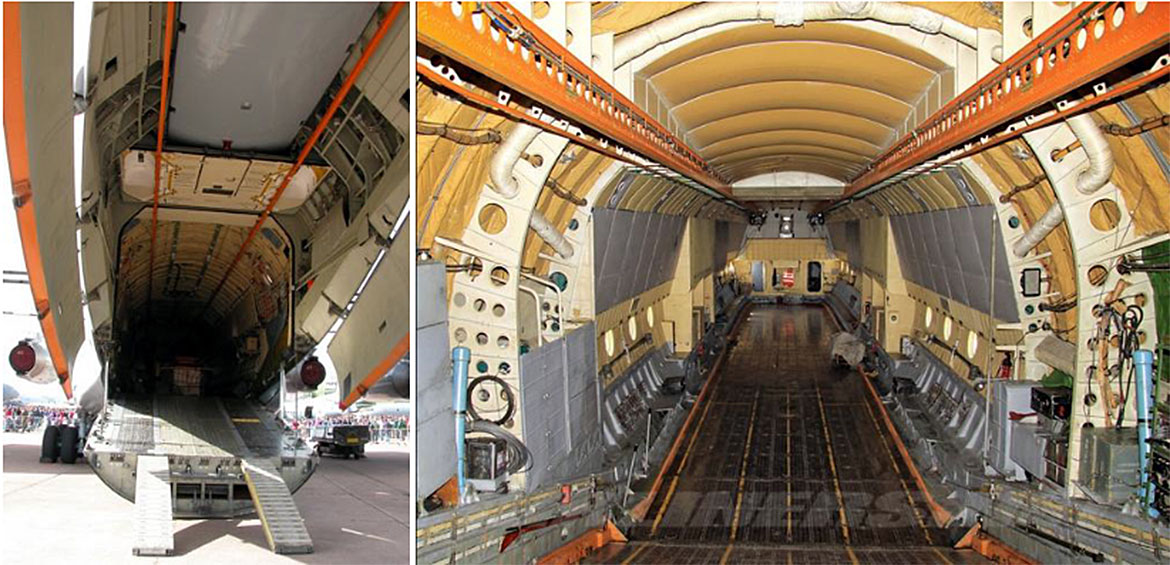
Ramp lowered ready to load
Internal view of the freight hold looking forward
Eventually the crew returned and we started the onload under the guidance of the Syrian Loadmaster. The ‘front enders’ were meanwhile in Station Ops doing a flight plan for their return to Syria. The loading of the trailers was pretty straightforward and all were ‘nosed’ in with the assistance of an aircraft tractor. We then restrained them in position and even though the chains were similar to ours the tensioners were quite different. (Unbeknown to me one of the team had acquired one as a souvenir which then appeared back in our crew room as a trophy). Once all was completed the aircraft departed soon afterwards. The whole process was repeated the next day, the same crew returned. It goes without saying that the second load was achieved in even quicker time as we knew the procedure by then. The Intelligence guys were more than happy with events and the information they had gleaned. As it was, later in the year, information started to appear in ‘Air Clues, Aircraft Recognition’ and other NATO aviation magazines.
For those unaware, all Soviet aircraft were given NATO codewords to simplify identification. Fighters were all F = Foxbat, Fulcrum, Bombers B = Backfire, Bison and cargo aircraft C = Coot, Cub, Candid.
As the years progressed, the IL76 was a frequent visitor and chartered aircraft were used throughout the world. Even the RAF used them quite often, especially during the Gulf War and Balkans operations. I too worked on them several times in many different role fits. Possibly the most frightening time being when we loaded several pallets of jerrycans of fuel and the Ukrainian crew stood watching on the flight deck whilst all puffing away on cigarettes!
Ian Berry
Spring 2024
For those unaware, all Soviet aircraft were given NATO codewords to simplify identification. Fighters were all F = Foxbat, Fulcrum, Bombers B = Backfire, Bison and cargo aircraft C = Coot, Cub, Candid.
As the years progressed, the IL76 was a frequent visitor and chartered aircraft were used throughout the world. Even the RAF used them quite often, especially during the Gulf War and Balkans operations. I too worked on them several times in many different role fits. Possibly the most frightening time being when we loaded several pallets of jerrycans of fuel and the Ukrainian crew stood watching on the flight deck whilst all puffing away on cigarettes!
Ian Berry
Spring 2024

From: Colin Eyre, Bridgend, Glamorgan
Subject: Visiting Aircraft
Hi Tony,
Akrotiri 1966/7 - Our DAMO received a call to say a RCAF C130 was diverting into us and they may need some assistance. As it turned out we were not required but I believe aircraft maintenance were. The reason for the diversion was that they were doing a visual check of the airframe as they had been shot at whilst flying over the “GAZA STRIP”.
Where have we heard that name before? I don’t think we were ever told where they had been going to or coming from.
Thanks again for the great newsletters.
Rgds Colin
Subject: Visiting Aircraft
Hi Tony,
Akrotiri 1966/7 - Our DAMO received a call to say a RCAF C130 was diverting into us and they may need some assistance. As it turned out we were not required but I believe aircraft maintenance were. The reason for the diversion was that they were doing a visual check of the airframe as they had been shot at whilst flying over the “GAZA STRIP”.
Where have we heard that name before? I don’t think we were ever told where they had been going to or coming from.
Thanks again for the great newsletters.
Rgds Colin


From: Barry Tappenden, Shortstown, Beds
Subject: Visiting Aircraft
Good evening Tony,
Whilst on FEAF MAMS I was detached to RAF Gan to "help out" in Air Movements (bit of a jolly). The civil Australian airline would troop through on a regular basis much to the delight of the "regulars" of RAF Gan as not only did it bring in fresh milk but an entourage of very attractive female air stewardess's. The only transport to convey these beauties to the Mess was a mini van (under my control). Once the milk was loaded into the van, two beauties climbed into the restricted space with one of them sitting in the middle of the seats stradling the gear stick! I can ensure you I drove very carefully avoiding the staring "green" glares of my fellow lads.
Barry
Subject: Visiting Aircraft
Good evening Tony,
Whilst on FEAF MAMS I was detached to RAF Gan to "help out" in Air Movements (bit of a jolly). The civil Australian airline would troop through on a regular basis much to the delight of the "regulars" of RAF Gan as not only did it bring in fresh milk but an entourage of very attractive female air stewardess's. The only transport to convey these beauties to the Mess was a mini van (under my control). Once the milk was loaded into the van, two beauties climbed into the restricted space with one of them sitting in the middle of the seats stradling the gear stick! I can ensure you I drove very carefully avoiding the staring "green" glares of my fellow lads.
Barry


From: Barry Tappenden, Shortstown, Beds
Subject: Ham 'n' Jam & Maj John Howard
Hi again Tony,
Subject: Ham 'n' Jam & Maj John Howard
Hi again Tony,

I jumped from 10,000' for Ham 'n' Jam and Maj John Howard
I just exited an aircraft at 10,000 feet in a tamden jump to raise money to erect a permanent monument to my father, Cpl Ted "Ham and Jam" Tappenden and Major John Howard. A monument will show the Major and Ted sending out the codes for the successful capture of the Pegasus and Horsa bridges (intact) on D-Day, 6th June 1944... Ham and Jam.
I have created a JustGiving page: https://www.justgiving.com/crowdfunding/barry-tappenden-1... please give generously as we must always remember the bravery and courage of the men of the Coup de Main.
Cheers!
Barry
I have created a JustGiving page: https://www.justgiving.com/crowdfunding/barry-tappenden-1... please give generously as we must always remember the bravery and courage of the men of the Coup de Main.
Cheers!
Barry
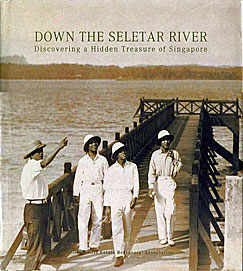

From: Roger Whittington, Prescot, Merseyside
Subject: Visiting Aircraft
Hi Tony,
I am just returning from a battlefield tour which is concerned with the Dambuster's Raids and The Great Escape, also taking in a visit to Colditz for good measure. I’m starting to become very interested in these tours, last month I went to the Somme and Ypres, and in May I will be visiting the D-Day beaches. I can thoroughly recommend a company called Leger Holidays for these trips as their tour guides are experts in their fields.
I have a few visiting aircraft stories from Lyneham. The foreign aircraft section was always busy and there were all nationalities popping in. I know there was a famous incident when an Iraqi crew had a “High Noon”-style shootout in the lobby of the Route Hotel with a crew from Iran. I guess no-one in Ops had read the memo stating that aircraft from nations who were at war with each other should not be given the same chock times! I can remember crews from the Gulf states taking taxis to Marks and Spencers in Oxford St, London to buy vast quantities of underwear (UFTBO- Undergarments For The Bahrainis and Omanis) and then spending an hour cutting all of the St Michaels labels out (St. Michaels is the trade mark for Marks and Spencers department store and is Israeli owned).
One incident that really sticks out in my mind concerns a Hercules from the Royal Indian Air Force. When this particular aircraft landed it was sent to park on bay 42 which as any old Lyneham hand will tell you, had quite a slope on it. There must have been about 30 or 40 Indian meeters and greeters waiting at the bay who were milling around, getting in the way as the crew deplaned. Suddenly, the aircraft started to roll backwards as the responsible crew member must have forgotten to put the parking brake on. To everyone’s horror (and glee) the rabble tried to stop the aircraft rolling backwards by pushing on the undercarriage doors by the GTC outlet. It was only the quick thinking of a crew member who jumped back onto the aircraft and did the necessary that prevented us from having to clean up a load of squashed consular staff!
Another incident, which was a bit embarrassing for me, happened when I was a pax clerk in Akrotiri. We had a detachment of Starfighters visiting and there had been a lot of chatter about them. They had a few nicknames like “flying coffin” etc and I was told that the easiest way to own an actual Starfighter was to buy a plot of land in Germany and sooner or later one would crash into it! One day we had a Compassionate Bravo returning to the UK on the scheduled VC10 - a Mrs Widdowson - and I had received the C-sign from the WO to escort her to the aircraft. As we walked across the pan we passed the Starfighters and I recalled some of the conversations about them. A bad move as it turned out because I introduced the Comp Bravo as “Mrs Widowmaker” - Whoops!
Great work as usual Tony!
Subject: Visiting Aircraft
Hi Tony,
I am just returning from a battlefield tour which is concerned with the Dambuster's Raids and The Great Escape, also taking in a visit to Colditz for good measure. I’m starting to become very interested in these tours, last month I went to the Somme and Ypres, and in May I will be visiting the D-Day beaches. I can thoroughly recommend a company called Leger Holidays for these trips as their tour guides are experts in their fields.
I have a few visiting aircraft stories from Lyneham. The foreign aircraft section was always busy and there were all nationalities popping in. I know there was a famous incident when an Iraqi crew had a “High Noon”-style shootout in the lobby of the Route Hotel with a crew from Iran. I guess no-one in Ops had read the memo stating that aircraft from nations who were at war with each other should not be given the same chock times! I can remember crews from the Gulf states taking taxis to Marks and Spencers in Oxford St, London to buy vast quantities of underwear (UFTBO- Undergarments For The Bahrainis and Omanis) and then spending an hour cutting all of the St Michaels labels out (St. Michaels is the trade mark for Marks and Spencers department store and is Israeli owned).
One incident that really sticks out in my mind concerns a Hercules from the Royal Indian Air Force. When this particular aircraft landed it was sent to park on bay 42 which as any old Lyneham hand will tell you, had quite a slope on it. There must have been about 30 or 40 Indian meeters and greeters waiting at the bay who were milling around, getting in the way as the crew deplaned. Suddenly, the aircraft started to roll backwards as the responsible crew member must have forgotten to put the parking brake on. To everyone’s horror (and glee) the rabble tried to stop the aircraft rolling backwards by pushing on the undercarriage doors by the GTC outlet. It was only the quick thinking of a crew member who jumped back onto the aircraft and did the necessary that prevented us from having to clean up a load of squashed consular staff!
Another incident, which was a bit embarrassing for me, happened when I was a pax clerk in Akrotiri. We had a detachment of Starfighters visiting and there had been a lot of chatter about them. They had a few nicknames like “flying coffin” etc and I was told that the easiest way to own an actual Starfighter was to buy a plot of land in Germany and sooner or later one would crash into it! One day we had a Compassionate Bravo returning to the UK on the scheduled VC10 - a Mrs Widdowson - and I had received the C-sign from the WO to escort her to the aircraft. As we walked across the pan we passed the Starfighters and I recalled some of the conversations about them. A bad move as it turned out because I introduced the Comp Bravo as “Mrs Widowmaker” - Whoops!
Great work as usual Tony!
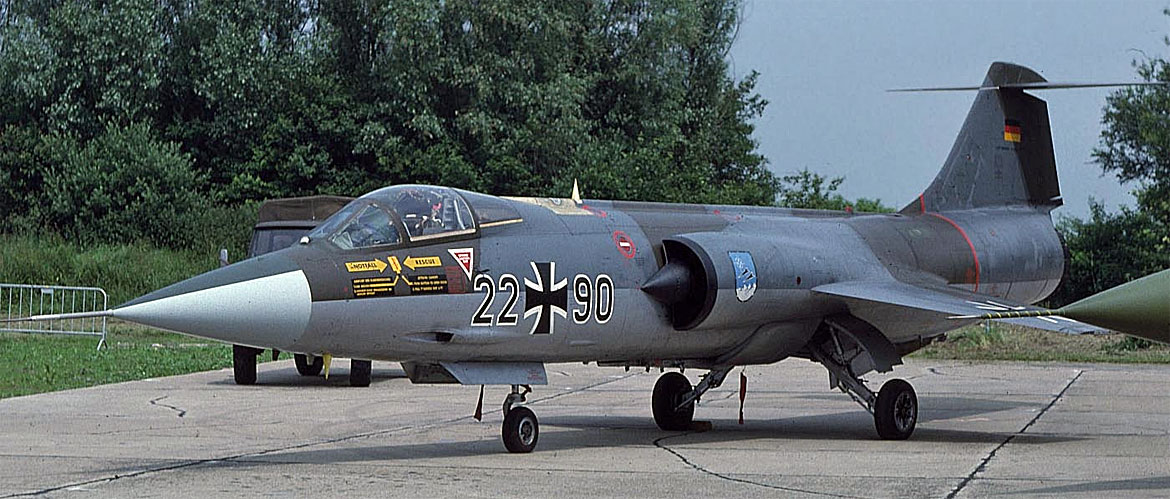
A Luftwaffe F-104 Starfighter - "The Widow Maker" - extremely accident prone


From: John Furney, Dymock, Gloucestershire
Subject: Visiting Aircraft
Dear Tony,
Sitting on the veranda of the movements squadron in Bahrain in 1965, daydreaming of pastures green whilst the tail end of a sand storm blew through, there suddenly appeared out of the gloom a USAF Boeing KC-135 Stratotanker which was the biggest military plane we had seen in Bahrain (bearing in mind that the RAF's main transport aircraft at that time was the Britannia) and it was heading straight towards us. A quick phone call confirmed that it was on diversion and expected to stop for a couple of hours.
For the uninitiated, the KC-135 has no windows and usually is packed with fuel tanks for its air to air refuelling role. With the usual dexterity, we took a set of passenger steps up to a door which had been opened towards the nose of the aircraft and was greeted by what I suppose was the loadmaster. After a half hour conversation or so the crew were ready to disembark and go to the ops room. Just as the last went down the steps the loadmaster asked what to do with the passengers! Well, looking down the aircraft there was no light so everything was pitch black and we could not distinguish anything. Apparently there were 70 or more passengers including a two-star General all sitting there. Of course the embarrassment was intensified as they had been patiently waiting in a really stuffy plane with no air conditioning and in sweltering heat. To cut a long apology down to size, it is suffice to say that the NAAFI bar within the Movements building made a handsome profit that day and luckily after a couple of gins the general was very amenable and I think put the whole episode down to us being British or was it Limeys?
Subject: Visiting Aircraft
Dear Tony,
Sitting on the veranda of the movements squadron in Bahrain in 1965, daydreaming of pastures green whilst the tail end of a sand storm blew through, there suddenly appeared out of the gloom a USAF Boeing KC-135 Stratotanker which was the biggest military plane we had seen in Bahrain (bearing in mind that the RAF's main transport aircraft at that time was the Britannia) and it was heading straight towards us. A quick phone call confirmed that it was on diversion and expected to stop for a couple of hours.
For the uninitiated, the KC-135 has no windows and usually is packed with fuel tanks for its air to air refuelling role. With the usual dexterity, we took a set of passenger steps up to a door which had been opened towards the nose of the aircraft and was greeted by what I suppose was the loadmaster. After a half hour conversation or so the crew were ready to disembark and go to the ops room. Just as the last went down the steps the loadmaster asked what to do with the passengers! Well, looking down the aircraft there was no light so everything was pitch black and we could not distinguish anything. Apparently there were 70 or more passengers including a two-star General all sitting there. Of course the embarrassment was intensified as they had been patiently waiting in a really stuffy plane with no air conditioning and in sweltering heat. To cut a long apology down to size, it is suffice to say that the NAAFI bar within the Movements building made a handsome profit that day and luckily after a couple of gins the general was very amenable and I think put the whole episode down to us being British or was it Limeys?

A Boeing KC-135 Stratotanker - no windows for the passengers
Another favourite visiting aircraft to Bahrain, but to the civil airport, was the Czech airlines Tupolev TU-114. The attraction came to light when it ran off the runaway (not for the last time) and the RAF were asked to help pull it out of the sand. This time after the rescue had been achieved a few of us ubiquitous movers who were in attendance giving the VASF techies helpful encouragement when needed were invited aboard the aircraft and to our surprise offered pints of draft Watneys Red Barrel. Well, if that was not sufficient to build a good relationship with the airline over I'm not sure what is? Sadly it only lasted a couple of more visits as the barrels were eventually emptied and the airline decided to stop carrying draft beer, well at least to Bahrain.


The Tupolev TU-114 - serving Watney's Red Barrel beer made it the Mover's favourite visitor!
Raised eyebrows when Ops advised us of the imminent arrival of a Lancaster “Spirit of Surfers Paradise”. Apparently only the third flying Lancaster in the world was en route from Australia to the UK. It was being flown by a civilian crew with a Qantas pilot as Captain. It arrived on three engines and disgorged a host of Australians some of whom had paid for a seat in the aircraft. Overnight the fourth engine was repaired and with a lot of nostalgia the four Merlin engines revved up and she took to the sky en route to Akrotiri. Rumour has it that it wasn’t until the aircraft had actually overflown certain Middle East countries that those countries eventually realised that a Lancaster was a bomber and should not have been given clearance - I expect that it was those smooth talking Australians that did the trick! As a footnote the aircraft arrived at Biggin Hill bang on schedule after its 19 day flight but was grounded because of an out of date engine. However it was allowed to fly again for a couple of flights before being permanently grounded at RAF Scampton and she now resides at the Lincoln Aviation Heritage Centre at Spilsbury.
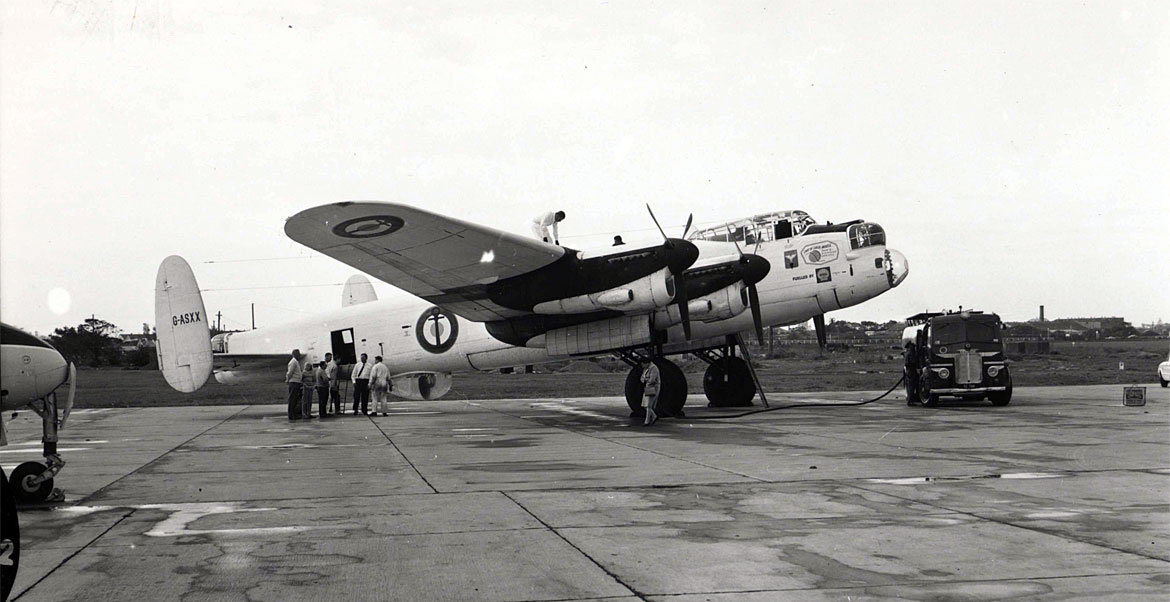
All the best and do continue to write down all those interesting anecdotes before they are lost forever.
John
John

From: Jelle Hieminga, Amsterdam
Subject: Wrapping up 'A Spot of Bother'
Hello Tony,
A while ago the full story of the box of missile spares that turned up at Montevideo was unearthed thanks to Dick King's story 'A Spot of Bother' and its republication in Old Bods Briefs 013124. Now that the whole story appears to be out there, I figured I would add the two accounts from Dave Green and Gordon Gray to the story on my website so that the entire saga is complete. It serves as a bit of closure to this story from the different points of view. I also figured I would wait a while before publishing this as the scoop belongs to the UKMAMS Old Bods Association of course.
Now that some time has passed... I have created a version of the page with the additions at the bottom: https://www.vc10.net/History/Falklands_40years.html
I have included links to the UKMAMSOBA website and the two newsletters so that visitors can find these too.
With kind regards,
Jelle Hieminga
Subject: Wrapping up 'A Spot of Bother'
Hello Tony,
A while ago the full story of the box of missile spares that turned up at Montevideo was unearthed thanks to Dick King's story 'A Spot of Bother' and its republication in Old Bods Briefs 013124. Now that the whole story appears to be out there, I figured I would add the two accounts from Dave Green and Gordon Gray to the story on my website so that the entire saga is complete. It serves as a bit of closure to this story from the different points of view. I also figured I would wait a while before publishing this as the scoop belongs to the UKMAMS Old Bods Association of course.
Now that some time has passed... I have created a version of the page with the additions at the bottom: https://www.vc10.net/History/Falklands_40years.html
I have included links to the UKMAMSOBA website and the two newsletters so that visitors can find these too.
With kind regards,
Jelle Hieminga

Tony Gale
ukmamsoba@gmail.com
ukmamsoba@gmail.com
Thankfully, there are no dedications for this month

From: Chris Goss, Marlow, Bucks
Subject: Streaming for the funeral service of Peter Cowan
Hi Tony,
Streaming details for the funeral service of Peter Cowan at 16:00 (BST) on Friday 3rd May, at North Wiltshire Chapel are as below.
Watching Live & On Demand
Website https://watch.obitus.com
Username lini3522
Password 933850
Subject: Streaming for the funeral service of Peter Cowan
Hi Tony,
Streaming details for the funeral service of Peter Cowan at 16:00 (BST) on Friday 3rd May, at North Wiltshire Chapel are as below.
Watching Live & On Demand
Website https://watch.obitus.com
Username lini3522
Password 933850



